
Your knees work hard during your daily routine, and arthritis of the knee or a knee injury can make it hard for you to perform normal tasks. If your injury or arthritis is severe, you may begin to experience pain when you’re sitting down or trying to sleep.
A total knee replacement involves cutting away the damaged bone of the knee joint and replacing it with a prosthesis. This "new joint" prevents the bones from rubbing together and provides a smooth knee joint.
The knee is a hinge joint consisting of three bones. The upper part of the hinge is at the end of the upper leg bone (femur), and the lower part of the hinge is at the top of the lower leg bone (tibia). When the knee is bent, the end of the femur rolls and slides on top of the tibia. A third bone, the kneecap (patella), glides over the front and end of the femur.
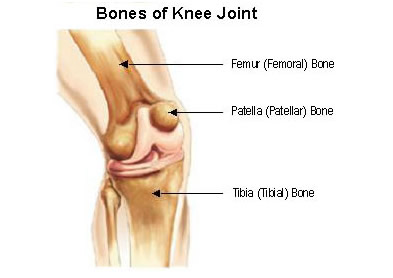
In a healthy knee joint, the surfaces of these bones are very smooth and covered with a tough protective tissue called cartilage. Arthritis causes damage to the bone surfaces and cartilage where the three bones meet and rub together. These damaged surfaces can eventually become painful.
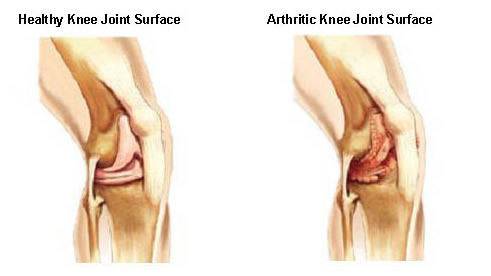
There are several ways to treat the pain caused by arthritis. One way is total knee replacement surgery. The decision to have total knee replacement surgery should be made very carefully after consulting your doctor and learning as much as you can about the knee joint, arthritis, and the surgery.
In total knee replacement surgery, the bone surfaces and cartilage that have been damaged by arthritis are removed and replaced with artificial surfaces made of metal and a plastic material. We call these artificial surfaces "implants," or "protheses."

The patient is first taken into the operating room and given anesthesia. After the anesthesia has taken effect, the skin around the knee is thoroughly scrubbed with an antiseptic liquid. The knee is flexed about 90 degrees and the lower portion of the leg, including the foot, is placed in a special device to securely hold it in place during the surgery. Usually a tourniquet is then applied to the upper portion of the leg to help slow the flow of blood during the surgery.
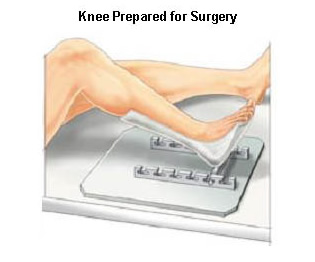
An incision is then made that typically extends from just above the knee to just below the knee. The incision is gradually made deeper through muscle and other tissue until the bone surfaces are exposed.
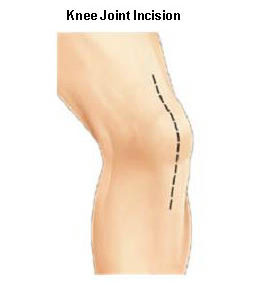

The damaged bone surfaces and cartilage are then removed by the surgeon. Precision instruments and guides are used to help make sure the cuts are made at the correct angles so the bones will align properly after the new surfaces (implants) are attached.
Small amounts of the bone surface are removed from the front, end, and back of the femur. This shapes the bone so the implants will fit properly. The amount of bone that is removed depends on the amount of bone that has been damaged by the arthritis.

A small portion of the top surface of the tibia is also removed, making the end of the bone flat.
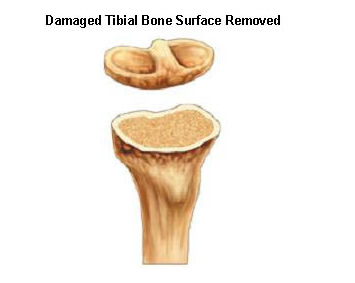
The back surface of the patella (kneecap) is also removed.
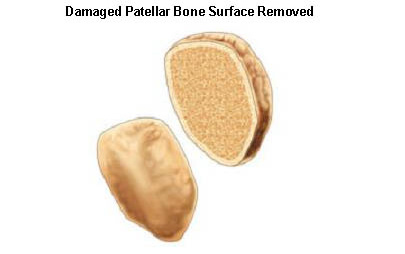

An implant is attached to each of the three bones. These implants are designed so that the knee joint will move in a way that is very similar to the way the joint moved when it was healthy. The implants are attached using a special kind of cement for bones.
The implant that fits over the end of the femur is made of metal. Its surface is rounded and very smooth, covering the front and back of the bone as well as the end.
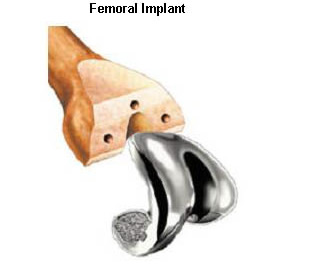
The implant that fits over the top of the tibia usually consists of two parts. A metal baseplate fits over the part of the bone that was cut flat. A durable plastic articular surface is then attached to the baseplate to serve as a spacer between the baseplate and the metal implant that covers the end of the femur.
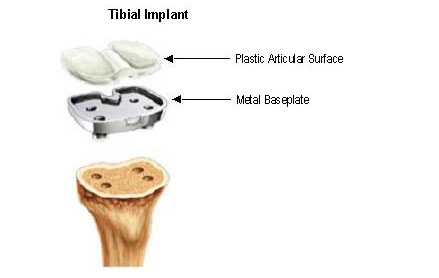
The implant that covers the back of the patella is also made of a durable plastic.
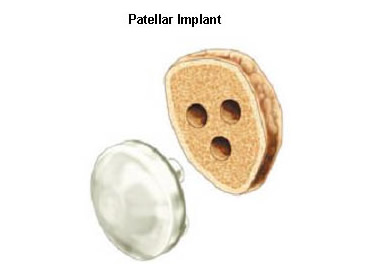
Artificial knee implants come in many designs. Some designs may have pegs, requiring small holes to be drilled into the bone after the damaged surfaces have been removed. Others may have central stems. In addition, some designs may allow screws to be used on the lower implant to provide added attachment security. The surgeon will choose the implant design that best meets the patient's needs.
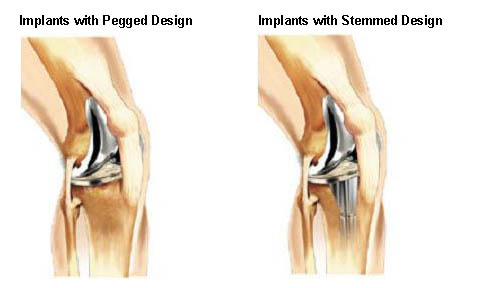

If necessary, the surgeon may adjust the ligaments that surround the knee to achieve the best possible knee function.
When all of the implants are in place and the ligaments are properly adjusted, the surgeon sews the layers of tissue back into their proper position. A plastic tube may be inserted into the wound to allow liquids to drain from the site during the first few hours after surgery. The edges of the skin are then sewn together, and the knee is wrapped in a sterile bandage. The patient is then taken to the recovery room.

VISIONAIRE™ Patient Matched Instrumentation brings you an innovative approach for a precise, custom-fit knee replacement. Your surgery will be unique to you, with surgical guides and instruments that are designed for the shapes and contours of your knee. You may experience less pain while accelerating your recovery time.
PATIENT MATCHED TECHNOLOGY
While choosing a high performance knee implant is central to regaining your active life, there is a new, technologically advanced surgical procedure that may extend the life of your knee replacement.
VISIONAIRE™ Patient Matched Technology is a remarkable system that uses your MRI and X-Ray images to design and build surgical instruments customised for your unique knee anatomy. While every person’s knee joint has subtle differences in shape and contour, traditional surgical instruments used to place knee implants are one-size-fits-all.
Using VISIONAIRE technology, your orthopaedic surgeon comes to the operating room equipped with single-use instruments, engineered exclusively for your knee by the leading innovator in orthopaedic technology – Smith & Nephew Orthopaedics.
IMPLANT LOGEVITY
A knee implant accurately aligned with the VISIONAIRE™ system may last longer than traditional knee replacements. Even a slightly misaligned implant can cause uneven implant wear, loosening and instability, which can contribute to early implant failure and follow-up surgeries.
TECHNOLOGY BENEFITS
Because VISIONAIRE™ technology removes multiple steps from the traditional surgery process, your time under anaesthesia may be reduced. This may lead to less blood loss and a lower risk of infection.
FASTER RECOVERY
Customised VISIONAIRE™ instruments enable a less invasive surgical procedure, which can reduce soft tissue and muscle damage. While this can speed your recovery time, the normal feel and movement of your knee may also accelerate your recuperation, as you won’t need additional time to adjust to a knee that does not ‘feel right’.
LESS PAIN
You may be able to take less pain medication for a shorter time with minimally-invasive surgery. By reducing the amount of muscle and soft tissue damage, you’ll have a smaller scar and may experience less pain during recovery.
ADVANCED IMPLANT MATERIAL FOR YOUR HIGH PERFORMANCE LIFE
Beyond natural motion and anatomical fit, a high performance knee implant must be made from the most technologically advanced materials in orthopaedics. The GENESIS™ II knee is made from OXINIUM™ Oxidised Zirconium, a unique metal alloy available only from Smith & Nephew.
WEAR-RESISTANT
In lab tests, ceramic-like OXINIUM™ material reduces knee implant wear by up to 85% compared to cobalt chrome – the metal used in virtually all other knee implants on the market. That means that the GENESIS™ II knee has the potential to last longer.
LIGHTWEIGHT
The thighbone component of the GENESIS™ II knee, which is the portion made with OXINIUM™ material, weighs a full 20% less than a similarly sized implant made from cobalt chrome.
HYPOALLERGENIC
OXINIUM™ Oxidised Zirconium is the only total knee implant material that contains no detectable amounts of nickel or chromium, the two metals associated with metal allergy. If metal jewellery irritates your skin, a GENESIS™ II knee made with OXINIUM™ metal may be right for you.
Get back to the activities you love, like swimming, golfing, walking, doubles tennis and even riding your bike.
|

